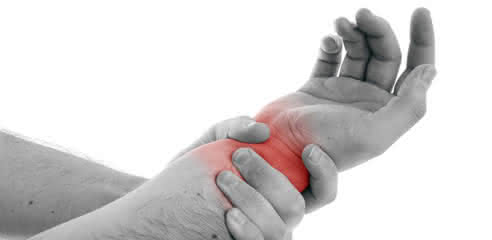Wrist Sprain: Symptoms, Diagnosis, and Treatment

What Is A Wrist Sprain?
A wrist sprain is caused by a sudden backward bend of the wrist into a hyperextended position, usually occurring when using the hand as protection when falling. This causes a stretch or tear in a ligament(s) that connect your hand bones to the bones in your forearm.
What Are The Symptoms Of A Wrist Sprain?
You experience pain, swelling, and tenderness in your wrist.
How Is A Wrist Sprain Diagnosed?
Your doctor will review your symptoms and examine your wrist upon a physical examination. He or she may order an x-ray to be sure you do not have any broken bones in your wrist.
What Is The Treatment For A Wrist Sprain?
Treatment may include:
- 1. Putting ice packs on your wrist for 20 to 30 minutes every 3 to 4 hours for 2 to 3 days, or until the pain goes away.
- 2. Elevating your wrist on the back of a chair or couch while sitting on a pillow while sleeping.
- 3. Taking an anti-inflammatory or other pain medication prescribed by your doctor.
- 4. Wearing a wrist sprain brace/splint or cast on your wrist to prevent further injury.
- 5. Doing exercises to help your wrist recover.
While you are recovering from your injury you will need to change your sport or activity to one that does not make your condition worse. For example, you may need to run instead of playing basketball.
When Can I Return To My Sport Or Activity?
The goal of rehabilitation is to return you to your sport or activity as soon as is safely possible. If you return too soon you may worsen your injury, which could lead to permanent damage. Everyone recovers from injury at a different rate. Return to your sport or activity will be determined by how soon your wrist recovers, not by how many days or weeks it has been since your injury occurred. In general, the longer you have symptoms before you start treatment, the longer it will take to get better.
You may return to your sport or activity when the injured wrist has full range of motion without pain. Your doctor may allow you to return to competition with your wrist taped or in a brace. Your injured wrist, hand, and forearm need to have the same strength as the uninjured side. You must not have any pain when doing activities such as swinging a bat or a racquet or performing tumbling in gymnastics.
How Can I Prevent A Wrist Sprain?
A wrist sprain usually occurs during an accident that is not preventable. However, when you are doing activities such as rollerblading be sure to wear protective wrist guards.
Wrist Sprain Rehabilitation Exercises:
You may do stretching exercises 1 through 5 when the sharp wrist pain goes away. You may do strengthening exercises 6 through 8 when stretching is nearly painless.
1. Active range of motion:
A. Flexion: Gently try to bend your wrist forward. Hold for 5 seconds. Repeat 10 times. Do 3 sets.
B. Extension: Gently bend your wrist backward. Hold this position for 5 seconds at each end. Repeat 10 times. Do 3 sets.
C. Side to side: Gently move your wrist from side to side, holding 5 seconds at each end. Repeat 10 times. Do 3 sets.
2. Stretching: With you uninjured hand, help to bend the wrist down by pressing the back of your hand and holding for 15 to 30 seconds. Next, stretch it backward by pressing the fingers in a backward direction and holding 15 to 30 seconds.
3. Wrist extension stretch: Stand at a table with your palms down, fingers flat, and elbows straight. Lean your body weight forward. Hold this position for 15 to 30 seconds.
4. Wrist flexion stretch: Stand with the back of your hands on a table, palms facing up, fingers pointing toward your body, and elbows straight. Lean away from the table. Hold this position for 15 to 30 seconds.
5. Pronation and supination of the forearm: With your elbow bent 90 degrees, turn your palm upward and hold for 5 seconds. Slowly turn your elbow at your side and bent 90 degrees throughout this exercise. Repeat 10 times.
6. Wrist flexion exercise: Holding a can or hammer handle with your palm up, bend your wrist upward. Slowly lower the weight and return to the starting position. Repeat 3 sets of 10. Gradually increase the weight of the can or weight that you are holding.
7. Wrist extension: Holding a can or hammer handle with your palm facing down, slowly bend your wrist upward. Slowly lower the weight down to the starting position. Repeat 10 times. Do 3 sets of 10. Gradually increase the weight of the object you are holding.
8. Grip strengthening: Squeeze a rubber ball and hold for 5 seconds. Repeat 10 times.
All material provided is designed for information purposes only and should not be used to replace the care of a health care professional. Do not rely on any of the information for diagnosis or treatment. It is recommended that you visit a qualified health care professional for individual and personal attention.